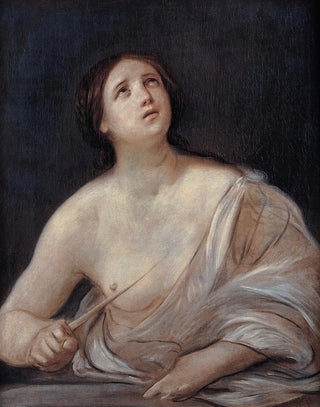Art print | Lucrece - Guido Reni Source: Reproduction | Lucrèce - Guido Reni


View from behind

Frame (optional)
Lucrezia Art print - Guido Reni – Captivating Introduction
The canvas "Lucrezia" by Guido Reni, painted in the early 17th century, embodies the very essence of Italian baroque, blending emotion and technique with unparalleled virtuosity. This masterful work, depicting the drama of a Roman heroine facing her tragic fate, draws the eye and provokes deep reflection on sacrifice and dignity. The scene, filled with tension and beauty, transports the viewer into a universe where art becomes the reflection of human passions. By contemplating this art print, one feels an intimate connection with the history and values that shaped Antiquity, while being enveloped by the light and shadows skillfully orchestrated by Reni.
Style and uniqueness of the work
Guido Reni's style is distinguished by his ability to fuse classicism and baroque, creating a unique aesthetic that transcends eras. In "Lucrezia", fluid lines and delicate contours depict a face imbued with melancholy, while the drapery, of an almost ethereal lightness, seems to dance around the central figure. The color palette chosen by the artist, oscillating between warm tones and darker shades, emphasizes the contrast between Lucrezia's beauty and the gravity of her act. Every detail, from the flashes of light caressing her face to the shadows enveloping her body, contributes to creating an atmosphere that is both tragic and sublime, capturing the very essence of the human condition.
The artist and his influence
Guido Reni, born in Bologna in 1575, is one of the undisputed masters of baroque. His artistic journey is marked by diverse influences, ranging from the Bolognese school to the impact of great masters such as Caravaggio. Reni developed a personal style that combines the rigor of drawing with powerful emotional expressiveness. His work profoundly influenced his contemporaries and subsequent generations, making him an iconic figure of Italian art. Through works like "Lucrezia", he conveyed universal values, addressing themes such as heroism, virtue, and suffering, which resonate

Matte finish

View from behind

Frame (optional)
Lucrezia Art print - Guido Reni – Captivating Introduction
The canvas "Lucrezia" by Guido Reni, painted in the early 17th century, embodies the very essence of Italian baroque, blending emotion and technique with unparalleled virtuosity. This masterful work, depicting the drama of a Roman heroine facing her tragic fate, draws the eye and provokes deep reflection on sacrifice and dignity. The scene, filled with tension and beauty, transports the viewer into a universe where art becomes the reflection of human passions. By contemplating this art print, one feels an intimate connection with the history and values that shaped Antiquity, while being enveloped by the light and shadows skillfully orchestrated by Reni.
Style and uniqueness of the work
Guido Reni's style is distinguished by his ability to fuse classicism and baroque, creating a unique aesthetic that transcends eras. In "Lucrezia", fluid lines and delicate contours depict a face imbued with melancholy, while the drapery, of an almost ethereal lightness, seems to dance around the central figure. The color palette chosen by the artist, oscillating between warm tones and darker shades, emphasizes the contrast between Lucrezia's beauty and the gravity of her act. Every detail, from the flashes of light caressing her face to the shadows enveloping her body, contributes to creating an atmosphere that is both tragic and sublime, capturing the very essence of the human condition.
The artist and his influence
Guido Reni, born in Bologna in 1575, is one of the undisputed masters of baroque. His artistic journey is marked by diverse influences, ranging from the Bolognese school to the impact of great masters such as Caravaggio. Reni developed a personal style that combines the rigor of drawing with powerful emotional expressiveness. His work profoundly influenced his contemporaries and subsequent generations, making him an iconic figure of Italian art. Through works like "Lucrezia", he conveyed universal values, addressing themes such as heroism, virtue, and suffering, which resonate






